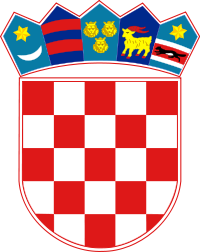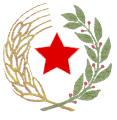Coat of arms of Croatia
| Coat of arms of Croatia | |
|---|---|
 |
|
| Details | |
| Adopted | 21 December 1990 |
| Crest | A crown of five arms, as follows: Azure a mullet of six points Or above a crescent argent; Azure two bars gules; Azure three leopard heads caboshed Or; Azure a goat statant Or unguled and armed gules; Azure on a fess gules fimbriated argent a marten courant proper in chief a mullet of six points Or. |
| Escutcheon | Chequy gules and argent. |
The Coat of arms of Croatia consists of one main shield and five smaller shields which form a crown over the main shield. The main coat of arms is a checkerboard (chequy) that consists of 13 red and 12 silver (white) fields. It's commonly known as šahovnica ("chessboard", from šah, "chess" in Croatian) or grb (literally coat of arms). The five smaller shields represent five different historical regions that comprise Croatia.
Contents |
History
The checkerboard coat of arms (šahovnica) is widely thought to have been created by Stephen Držislav in the tenth century.[1] It ranges in size from 3×3 to 8×8, but most commonly 5×5, like the current coat. It was traditionally conjenctured that the colours originally represented two ancient Croat states, Red Croatia and White Croatia, but there is no generally accepted proof for this theory. The oldest source confirming the coat as an official symbol is a genealogy of the Habsburgs, dated from 1512 to 1518. In 1525 it was used on a votive medal.
The oldest known coat of arms of Croatia (six-pointed star over a moon), coat of arms of Dalmatia and coat of arms of Slavonia (as well as the šahovnica) were all at times used as the Coat of Arms to represent the whole Croatia, especially in early heraldic period. Towards the Late Middle Ages the distinction for the three crown lands (Croatia 'proper', Dalmatia, Slavonia) was made. The šahovnica was used as the coat of arms of Croatia proper & together with the shields of Slavonia and Dalmatia was often used to represent the whole of Croatia in Austria-Hungary. It was used as an unofficial coat of arms of the Kingdom of Croatia adopted in 1848, and as an official coat of arms of the post-1868 Kingdom of Croatia-Slavonia. The two are the same except for the position of the šahovnica and Dalmatian coat of arms which are switched around & with different crowns used above the shield - the later employing St Stephen's crown (associated with Hungarian kings).
By late 19th century šahovnica had come to be considered a generally recognized symbol for Croats and Croatia and in 1919, it was included in the coat of arms of the Kingdom of Serbs, Croats and Slovenes (later the Kingdom of Yugoslavia) to represent Croats. When the Banovina of Croatia was formed, the šahovnica (chequy gules and argent) was retained as the official symbol.
The Ustashe regime which had ruled Croatia during the World War II superimposed their ideological symbol, the letter "U" above or around the šahovnica (upper left square white) as the official national symbol during their rule.
After the Second World War, the new Socialist Republic of Croatia became a part of the federal Second Yugoslavia. The šahovnica was included in the new socialist coat of arms with superimposed red star as a socialist ideological symbol. It was designed in the socialist tradition, including symbols like wheat for peasants and an anvil for workers, as well as a rising sun to symbolize a new morning and a red star for communism.
During the change to multiparty elections in Croatia (as part of the collapse of Communist rule in Eastern Europe from the late 1980s), and prior to the establishment of the current design, the šahovnica, shedding the communist symbols that were the hallmark of Croatia in the second Yugoslavia, reappeared as a stand-alone symbol as both the 'upper left square red' and 'upper left square white' variants. The choice of 'upper left square red' or 'upper left square white' was often dictated by heraldic laws and aesthetic requirements.
The current design
On 21 December 1990, the post-socialist government of Croatia, passed a law prescribing the design created by the graphic designer Miroslav Šutej, under the aegis of a commission chaired by Nikša Stančić, then head of the Department of Croatian History at the Faculty of Philosophy, University of Zagreb.
The new design added the five crowning shields which represent the historical regions from which Croatia originated. They are, from left to right:
- the oldest known Croatian coat of arms: a golden six-pointed star (representing the morning star) over a silver moon on a blue shield.
- an older coat of arms of the Republic of Dubrovnik: two red stripes on a dark blue shield. The coat of arms on the flags and stone portals of Dubrovnik were painted black as a sign of grief by Dubrovnik' s citizens after the invasion by Napoleon.
- the coat of arms of Dalmatia: three golden, crowned leopards, two over one, on a blue shield. This coat of arms originates from the Roman Emperor Diocletian who made his palace (the core of city of Split) the capital of the Western Roman Empire. His palace, to this day, still stands in Split.
- the coat of arms of Istria: a golden goat with red hooves and horns, on a dark blue shield.
- the coat of arms of Slavonia: two silver stripes on blue shield (representing the rivers Drava and Sava that mark the northern and the southern border of Slavonia), between them on a red field a black, running marten (kuna in Croatian - note national currency is related to the marten - Croatian kuna), above a six-pointed, golden star. This coat was to Slavonia was officially recognised by king Ladislaus Jagiello in 1496.
Some of the more traditional heraldic pundits have criticized the latest design for various design solutions, such as adding a crown to the coat, varying shades of blue in its even fields, and adding the red border around the coat. The government has accepted their criticism insofar as not accepting further non-traditional designs for the county coats of arms, but the national symbol has remained intact.
Unlike in many countries, Croatian design more commonly uses symbolism from the coat-of-arms, rather than from the Croatian flag. This is partly due to the geometric design of the shield which makes it appropriate for use in many graphic contexts (e.g. the insignia of Croatia Airlines or the design of the shirt for the Croatia national football team), and partly due to the fact that the Pan-Slavic colours are present in many European flags.
Gallery
 Coat of arms of Croatia used in 1527 as part of a seal on a document. |
_with_crown.svg.png) Coat of arms of the Kingdom of Croatia-Slavonia (1868 - 1918). The official version had St. Stephen's crown on it, symbolizing Hungarian ruler over Croatia. |
 Coat of Arms of Hungary in 1910, before the Treaty of Trianon |
 Common Coat of arms of Austria-Hungary from (1915–1918) |
.png) Middle Coat of arms of Austria-Hungary from 1915 |
 Coat of arms of the Kingdom of Yugoslavia (1918-1941) |
 Coat of arms of the Banovina of Croatia (1939-1943) |
 Greater coat of arms of the Banovina of Croatia (1939-1943) |
 Coat of arms of the Federal State of Croatia (1943-1945) |
 Coat of arms of the Independent State of Croatia (1941-1945) |
 Coat of arms of the Socialist Republic of Croatia (1945-1990) |
.svg.png) Coat of arms adopted in 1990 and briefly used until the current coat of arms was adopted later in 1990. |
 Current coat of arms of the Republic of Croatia (official since 21 December 1990) |
See also
References
- ↑ Bellamy, Alex J. (2003). The Formation of Croatian National Identity: A Centuries-old Dream. Manchester University Press. p. 36. ISBN 071906502X.
External links
- Republic of Croatia - Ministry of Foreign Affairs & European Integration
- Croatian Government website - Flag, Coat-of-Arms and National Anthem
- Croatian Coat of Arms during centuries - Darko Zubrinic, 2005
- Stan Granic: Evolution and use of the Croatian coat of arms, The Canadian Slavonic Papers, Sep-Dec 1996
- Croatia - Coat of Arms - Zeljko Heimer 2000
- Croatia - Proposals for New Flag in 1990 - Flags of The World
- Croatia - Political Flags - Flags of The World
- C. Michael McAdamas: Croatia - Myth and Reality
|
|||||||||||||||||||||||||||||
|
||||||||||||||||||||
